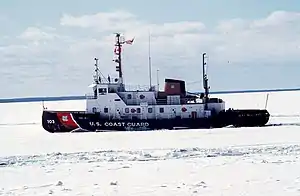USCGC Mobile Bay (WTGB-103)
USCGC Mobile Bay (WTGB-103) is an active Icebreaking Tug under the direction of the United States Coast Guard. Her homeport is located in Sturgeon Bay, Wisconsin. She is one of two ships in her class that has been equipped with a 120-foot Aids-to-Navigation barge operating on the Great Lakes.[1] The vessel was specifically designed to carry out icebreaking missions, but also carries out missions in Search and Rescue, Environmental Pollution Response, Maritime Law Enforcement and Homeland Security.[1]
 USCGC Mobile Bay (WTGB-103) | |
| History | |
|---|---|
| Namesake: | Mobile Bay, Alabama |
| Builder: | Tacoma Boatbuilding Company |
| Launched: | December 11, 1978 |
| Commissioned: | September 2, 1979 |
| Homeport: | Sturgeon Bay, Wisconsin |
| Identification: |
|
| Motto: | "Breaking the trail, Marking the way" |
| Status: | Active |
| General characteristics | |
| Class and type: | USCG Bay class Icebreaking Tug (WTGB) |
| Type: | Icebreaker tug |
| Displacement: | 690 tons |
| Length: | 140 ft |
| Beam: | 37.5 ft |
| Draft: | 12.5 |
| Ice class: | 60 inch continuous, 10 feet back/ramming |
| Installed power: | Diesel Electric |
| Propulsion: | Two Fairbanks-Morse diesel engines |
| Speed: | 19.7 knots (36 km/h) max |
| Boats & landing craft carried: |
1 Utility Boat 120-foot Aids-to-Navigation barge |
| Crew: | 30 |
During the fall season, CGC Mobile Bay is responsible for aids to navigation work in Green Bay and Lake Michigan. Mobile Bay is able to do ATON, unlike other 140’s, because it is one of two 140’s with a 120’ ATON barge. During this time, the cutter is tasked with replacing traditional channel markers with winter markers, which are more capable of handling the extreme conditions seen in the Great Lakes during the winter months. During the winter months, CGC Mobile Bay detaches from the ATON barge and is largely responsible for ice breaking in the Northern Great Lakes in order to maintain an operable level of maritime commerce in the region. This time period often lasts from December to Mid-April. During the spring months, CGC Mobile Bay once again is responsible for aids to navigation work. At this time, the cutter will replace the buoys set in the fall with the traditional channel markers, since the winter months will have ended. The cutter will also inspect year round buoys to ensure they are positioned correctly and watching properly.
See also
References
- "U.S. Coast Guard Cutter Mobile Bay". United States Coast Guard. Retrieved 2008-12-16.